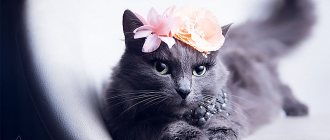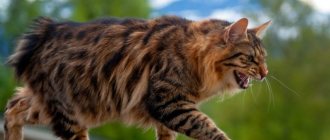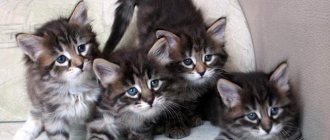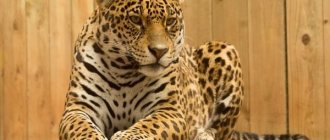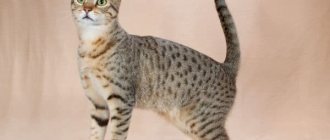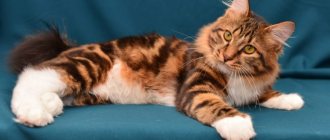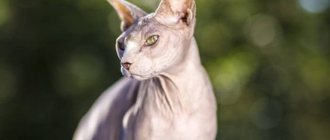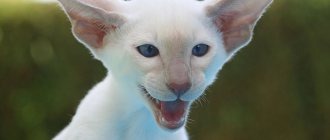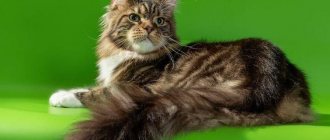Domestic cats are traditionally portrayed as good-natured and affectionate creatures, although expert opinions paint a completely different picture. According to the observations of experts, every cat is prone to demonstrating undisguised anger, and often uses aggression unmotivated when it strives for dominance and submission to its will. Let's find out which cats are on the list of the most dangerous breeds, and also figure out how to avoid attacks from them.
Top aggressive cat breeds
The list of the most aggressive cat breeds sometimes includes quite harmless animals that people simply have not found an approach to.
Maine Coons
The Maine Coon cannot be called completely safe, but it should not be classified as an evil pet either. Three external signs are enough to draw a conclusion about potential danger and innate anger:
- powerful body on large paws;
- a wary and stern predatory look;
- lynx tufts on the ears and measured, noiseless gait.
Cats of this breed resist excessive affection and can defend their food like a dog. In fact, the Maine Coon is absolutely harmless, and under normal conditions it will never take threatening actions. It is almost impossible to bring him into an attack of aggressive anger.
Balinese people
Representatives of the Balinese cat breed owe their aggressiveness to the Siamese. They have an explosive temperament, which is uncontrollable at the moment of active outburst.
Even being alone for a long time can make a Balinese angry. In this case, the owner will be greeted not by a gentle, sociable cat, but by an angry predator who can dig his claws into the hands outstretched to him.
Important! A characteristic feature of this cat is its dislike for strangers. She is not ready to demonstrate loyalty to all humanity and sometimes shows aggression for no reason.
British cats
An indigenous English breed that is included in the list of evil cats due to its difficult character. At first glance, one cannot suspect them of innate aggressiveness. This is exactly the case when appearances are deceiving, and laziness is feigned.
This breed of cat is not characterized by direct and causeless anger. But she is very proud, touchy, selfish and prefers solitude. Violation of any of the listed points becomes a reason for the cat's discontent. And it is expressed by those means that are available to the animal - claws and teeth.
True, before attacking the “offender”, the Briton will try to leave so as not to enter into conflict.
Scottish cats
The Scots are less aggressive than their British ancestors. Although, for the purpose of protection, they are capable of showing signs of anger - they can hiss, bend, fan their tail and raise the fur on their spine. Most often, after such a session of “intimidation”, even the most evil Scottish cats hide in a secluded place.
Savannah
The Savannah (a hybrid of an ordinary cat and a wild African serval) has a very complex pedigree line. Breeders wanted to combine the natural appearance of the spotted serval with the docile nature of a domestic cat.
They managed to achieve their goals, but the savannah cannot be called an animal that has fully adapted to living in a family. The innate qualities of an angry night hunter take their toll, and the impressive size (height at the withers reaches 60 cm) and the habit of attacking from the back look menacing.
In the 3-4th generation, Savannahs (wild blood content is about 10-25%) are quite friendly towards people, demonstrate a desire to communicate and are easy to learn. They even walk on a leash, sniffing with interest everything that comes along the way.
Important! During the mating season, cats' behavior changes dramatically. At this moment they become angry and aggressive - this reaction is caused by a natural desire to fight for procreation.
Manul
Manul is one of those breeds that cannot be tamed. These cats are too freedom-loving and will never obey a person.
It is worth noting that the disobedience of the Pallas cat is primarily due to the fact that he is not a domestic cat, but a wild one. That is, these cats feel very comfortable living in natural conditions, but they are not adapted to living side by side with humans.
As soon as the manul senses danger, he will immediately attack the person. Its claws are considered very powerful by feline standards, and its fangs are 3 times longer than those of an ordinary cat. It is worth noting that Pallas cats not only behave aggressively, but also look quite menacing.
Predatory cats
Scientists have long confirmed that all modern cats descended from 5-10 species of evil wild animals. Breeders continue to crossbreed different breeds in hopes of creating the perfect wild-looking cat. Most often, such efforts end in a genetic fiasco or natural anger takes over.
Then the seemingly harmless animal becomes a serious threat to others. To understand the danger of such connections, it is necessary to understand which of the wild ancestors represent the parental line of the pet.
jungle cat
A large predatory animal in a brown-gray color, with tufts on the ears and the character of a hunter. Males grow up to 90 cm. Such a pet can be kept in the house, especially if upbringing begins in childhood.
Evil jungle cats always guard their territory, according to the centuries-old instinct of dividing into zones of influence with other animals. Therefore, all the talk about neutral relationships with pets looks very unconvincing.
At the first opportunity, the evil jungle cat will establish its own order and drive away all strangers from the territory.
It is not recommended to keep a jungle cat indoors. This evil breed is best suited to an equipped spacious enclosure, where all conditions for a comfortable life will be created.
Wild manul
A predatory and very angry cat with short legs and a dense, massive body. It is half the size of its reed predecessor and weighs about 5 kg. The breed is notable for its thick and fluffy coat - up to 9 thousand hairs grow per 1 cm2. But such a miniature (by natural standards) build and harmless appearance should not be misleading.
The aggressiveness of this cat is at the highest level of danger, and its ability to track down prey and silently attack it leaves practically no chance of a successful outcome. The Pallas's cat does not hunt humans, because it understands the difference in size, but it is not accustomed to retreat either. If such a cat gets angry and attacks the offender, then it will not be possible to get away with a slight fright.
Even as a kitten, this breed exhibits anger. Therefore, you will have to make a lot of effort to convince the Pallas's cat of the need to humble his proud disposition.
No one has ever been able to completely tame a cave cat; it cannot tolerate hygiene procedures, and it will not stop hunting under any circumstances. An exotic wild pet can only be kept in an enclosure.
Causes of aggressive behavior
All domestic cats have the same reasons for their anger. In the first place are breed qualities. Bengals, British, Siamese cats have an innate tendency towards aggression. It manifests itself differently in everyone, but the predisposition is fixed by genetic development.
The second reason is improper upbringing. Any cat can become evil, even if it belongs to the order of decorative tigers or harmless ragamuffins.
Third – living conditions and stress. Loud sounds, unusual smells, lack of attention from the owner - the cat evaluates all the circumstances and reacts to them. Also, a cat’s mood changes during the mating period.
How does aggression manifest itself?
In the list of the most aggressive cat breeds you can find representatives of those species that are never perceived with caution. Moreover, it is in such groups that the greatest risk is hidden - careless behavior or accidental psychological provocation can seriously anger a pet.
This behavior was inherited by modern evil cats from distant predatory ancestors. Unlike other animals, which give advance warning of an impending attack, felines often attack suddenly.
However, if you can retreat and hide, any cat, angry by nature or just irritated, will take this opportunity.
The first sign of nervous excitement and accumulated anger is hissing. At the same time, a “ridge” of fur rises along the cat’s spine and its tail fluffs out.
Another sign of aggression that indicates readiness to attack is pinned ears and tail thumping on surfaces.
Bengal
Another representative of the evil cat family is the Bengal, with a pronounced hunting instinct and incredibly impressive appearance. Many of the representatives of the Bengal breed have impulsive character traits, due to which the animal becomes aggressive, capable of even attacking the owner in case of contradictions.
Raising your voice, much less shouting, is not tolerated. Day after day, Bengals tirelessly drive everywhere, and this continues until old age. Not everyone will like this. If the owner does not want to get a pet that will constantly attack him, he needs maximum attention, affection and care for the representatives of the breed.
How to deal with an angry pet
There are a number of standard recommendations that will help cope with aggression in your pet.
- Raising a cat should be done from early childhood - then it will be easier for the owner to understand the reasons for this behavior and calm the angry pet.
- Showing aggression is not a reason to panic - give the cat the opportunity to hide in a place comfortable for him so that he calms down.
- If attacks of aggression recur regularly, you need to take your pet to the veterinarian to rule out rabies.
- At the first signs of angry excitement (hissing, raising the ridge on the back), you can try to distract the cat with noise, for example, playing loud music.
- It is better not to look into the eyes of an excited pet - he may perceive such behavior as a signal to attack.
Owners of all cats are divided into two groups. The former arrogantly believe that the pet will withstand all the whims of the owner and will perceive him as the leader of the family pack. And the latter know exactly the limits of cat tolerance and never cross them.
In this case, a harmonious and peaceful community of man and cat is formed, in which there is a place for common games and the opportunity to take a break from each other.
Chausie
The chausie is also not of the kindest disposition; it is wild and capricious, slightly reminiscent of a puma in appearance. The chausie is distinguished by its size and highly developed hunting instinct. There is no place for them in a small apartment because of their large dimensions and desire to run around, their love of occupying mezzanine and above closet spaces, creating reserves and secret storage areas, which the owners will periodically access.

